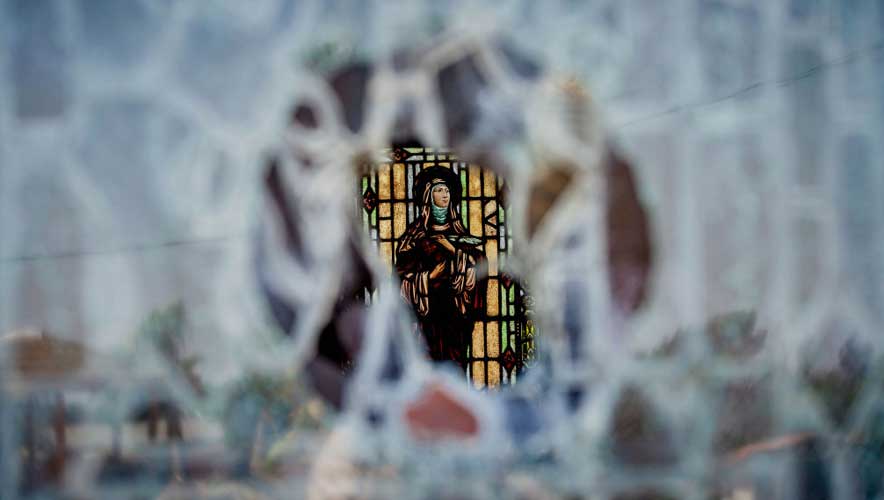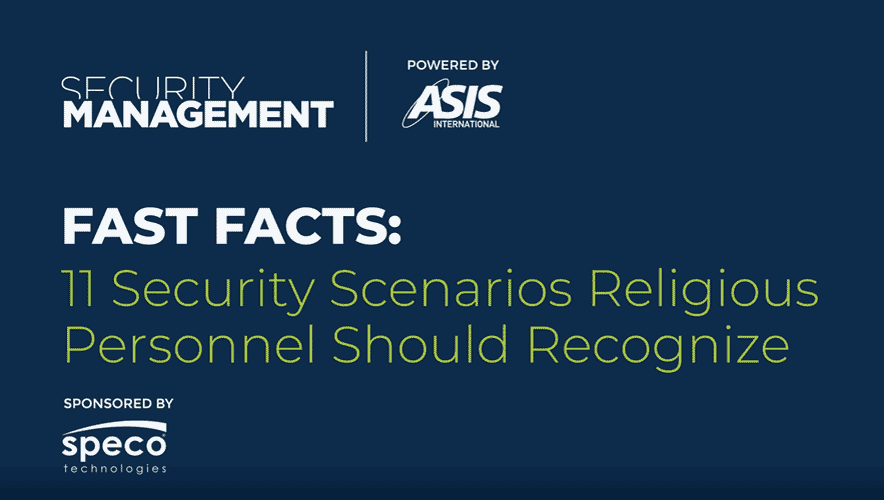PRAY: A Model to Change Mindsets about Security in Houses of Worship
Since antiquity, humans have destroyed monumental pieces of art, desecrated holy places, and attacked cultural centers in times of war, times of unrest, and times of polarization. Historically, sanctuaries have been particularly vulnerable to violent attacks. The Prince William's Parish Church in South Carolina, for instance, was burned by British forces in 1779 during the U.S. Revolutionary War, was rebuilt in 1826, and then burned again in 1865 during the U.S. Civil War. But incidents at houses of worship frequently occur outside of active conflicts, including to bombings at U.S. Black churches during the civil rights era, an attack on a major Jewish cultural center in Argentina, and the 2019 mass shooting at mosques in Christchurch, New Zealand.
SponsoredSpeco Technologies has the solutions to protect YOUR House of WorshipClick the link to enlighten yourself on how you can keep your House of Worship better defended with Speco Technologies |
The 1954 Hague Convention and its two optional protocols provide a detailed international legal framework for the protection of cultural property during armed conflicts, and this includes houses of worship. Under the International Criminal Court’s Rome Statute, it is a serious violation of laws and customs applicable in international armed conflict to intentionally direct attacks against protected objects, including buildings dedicated to religion, art, or education. However, those agreements do not always protect people and cultural properties. In the war between Russia and Ukraine, hundreds of cultural heritage sites have been damaged or destroyed, including more than 100 religious sites, according to the United Nations Educational, Scientific, and Cultural Organization (UNESCO).
Houses of worship have been both intentional targets and convenient sites to attack large groups of people or further their own ends.
On 15 January 2022, a man took worshippers at a Texas synagogue hostage as he negotiated for the release of a convicted terrorist. The FBI later declared the incident an act of terrorism and a hate crime.
On 28 January 2023, seven civilians were killed and three others were injured in a shooting attack near a synagogue on Neve Yaakov Street in Jerusalem. The alleged shooter was later killed by police forces.
On 30 January 2023, a suicide bomber targeted a mosque in the city of Peshawar, Pakistan. The attacker used a police uniform to gain access to the area; the powerful explosion left 101 people dead and more than 220 others injured.
It is clear that attacks on houses of worship are not conducted solely for religious or ideologically motivated violence; instead, they are often symptomatic of a rise in hostility overall. Additionally, these incidents are not geographically contained, and they can happen in Europe, New Zealand, Asia, or almost any country around the world.
Whether the organization is a megachurch, mosque, synagogue, gurdwara (a Sikh place of worship), temple, or a faith-based community, people in charge of protecting houses of worship require a shift in mindset to boost awareness and security.
Some religious leaders balk at the concept of restricting access to houses of worship because they are traditionally places of peace, rest, and welcome. And while this is the typical state for many religious institutions, a sense of alertness is required.
According to U.S. Lieutenant Colonel David Grossman in his book On Combat: The Psychology and Physiology of Deadly Conflict in War and in Peace, there are three types of people:
- Sheep (healthy, productive citizens who have no capacity for violence),
- Wolves (aggressive sociopaths, terrorists, criminals, active assailants, those who aim to hurt the innocent), and
- Sheepdogs (protectors who have the capacity for violence but in defense of their fellow citizens).
Wolves will do anything they can to attack sheep, Grossman wrote, which necessitates the presence of protective sheepdogs who will help keep watch and respond to danger, even though their presence can sometimes make sheep nervous.
When communicating this need to stakeholders at houses of worship (clergy, elders, administrators, congregants), consider using the acronym PRAY to help shift mindsets and develop a more security-conscious culture: Prepare, Reset, Act, and Yield.
Prepare
In case your house of worship does not have an ongoing security prevention and response plan, many government agencies—including U.S. agencies such as the Department of Justice, Department of Homeland Security (and its Cybersecurity and Infrastructure Security Agency, CISA), and the Federal Emergency Management Agency (FEMA)—have vast amounts of literature available to help security teams protect houses of worship against potential acts of hate and violence.
Regardless the size of your house of worship, have always a holistic point of view about security, looking beyond the building’s doors and looking at processes and people to identify possible risks and address them.
Each house of worship is unique, so understanding the context of a specific location will help security professionals identify and assess threats to define the risk landscape in that particular community.
Make a facility characterization of your house of worship based on design basis threat (DBT), a methodology that examines the capabilities of an attacker—whether an insider or an outsider—and evaluate security steps based on that profile.
From there, establish several layers of security, such as the interior perimeter, building perimeter, parking lot perimeter, property perimeter, and a broad, district-wide perimeter. Consider how principles of crime prevention through environmental design (CPTED) can help to deter criminal behavior. Some deterrents, technology, and natural barriers might already be in place and just need to be updated—check video surveillance coverage, secure fencing, pedestrian and vehicle gates, locks, security screens on windows, lighting, berms, tree trimming, and bollards.
Reset
This is the most important step and one of the most challenging: a shift in culture.
As a religious community, every house of worship has a distinctive mindset—they share a way of thinking about their beliefs, values, and ideology, and they have a collective identity attached to a set of shared faith attributes. One perception they share is that houses of worship are meant to be places of shelter, reflection, and peace, where members come for devotion, veneration, or religious study.
Unfortunately, extremists and malicious actors have no qualms about taking advantage of this culture to gain access to targets. A mindset shift for religious stakeholders is not about eradicating the goal of a peaceful, welcoming environment, but it’s more about awareness—making all faith members alert to the security challenges they face, finding the balance that fits best with their unique needs, and being able to safely gather without fear of harm.
Efforts on this front should focus on the congregation members—not just policymakers like house of worship leaders or security managers. The fact that the community shares a collective identity does not mean all members think the same. There are differences and similarities in how they make sense of the world. One-on-one dialogues are a powerful tool to shift people’s thinking, so security leaders should talk to every faith member, explain they do not have to be afraid to attend your house of worship, and motivate them to feel like knights defending a medieval castle—a place of safety that must be guarded. This sense of protection and ownership will encourage congregants to watch for even small incidents and report them.
Potential threats toward a house of worship can escalate in a short amount of time, moving from graffiti or vandalism to car bomb, active shooter event, IED attack, or suicide extremist. Perpetrators can be extremists who are not interested in hurting any particular member of your house of worship, but instead they intend to harm what the religious institution represents to them.
Therefore, house of worship members and stakeholders should make a temporary switch in their mindsets, shifting from sheep to alert sheepdog to deter, deny, or respond to threats.
Act
In times of heightened risk, action must be taken. Consider shaking up routines, such as changing schedules for worship or gatherings and sharing the new schedule with members only. Have some members patrol the perimeter during services. Invite law enforcement officers, firefighters, and other first responders to a meet-and-greet over coffee to discuss threats or security responses. Establish a security strategy for screening mail and delivery boxes. Develop a security-conscious protocol—including verifying identities or looping in law enforcement as needed—for greeting or helping unknown visitors who ask for food or shelter.
Yield
Track records of hate crimes and incidents against houses of worship in your county, state, country, and worldwide to develop lessons learned to share with members. Report any security incidents from your location to federal agencies and other houses of worship. These efforts should yield results, especially as the house of worship produces bulletins, lessons learned, and flyers to inform and educate others about the risks faced by religious institutions.
Martin Luther King Jr., said, "Darkness cannot drive out darkness; only light can do that. Hate cannot drive out hate; only love can do that."
I believe in those words, and houses of worship boost those bonds of love every day. Caring for each other with passion and willpower shows extremists plainly they will never defeat your community.
Jaime Alejandro Pulido Pardo, CPP, retired as a major from the Colombian Army following 20 years of active-duty experience in combat, instructing, evaluating training, and leadership. He worked as a security contractor in the United Arab Emirates. He managed Colombian teams for executive protection for movie stars like Tom Cruise, Penelope Cruz, Javier Bardem, and Peter Sarsgaard while filming in Colombia.












